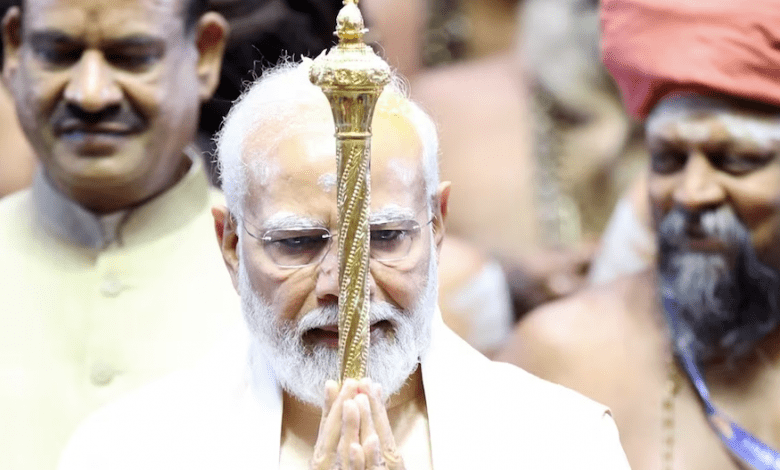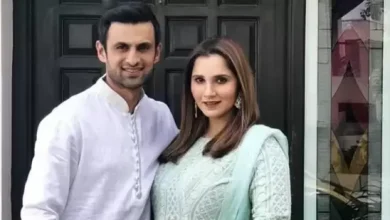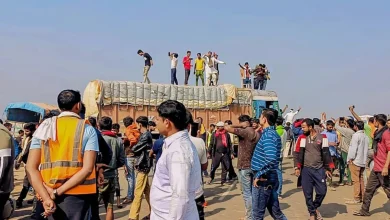The Nation Witnesses PM Modi Inaugurate the New Parliament House and Introduce “Sengol” in the Process

NEW DELHI: Indian Prime Minister Narendra Modi successfully inaugurated the New Parliament Building in a traditional manner with utmost sincerity on Sunday, May 28, 2023. Since everything is new, India might have a new parliament building name.
Table of Contents
The Significance
Parliament Inauguration is a huge occasion that denotes the start of another legislative session and praises the standards of a democratic government. It is an event where pioneers, administrators, and residents meet up to observe the transfer of power and reaffirm their obligation to the vote-based process.
The New Parliament Controversy
The building of the New Parliament was found in the middle of controversies in the country even before its work was started. Recalling the moment, back in the year of 2020, when India, a country as a whole, was facing very difficult times while fighting the Covid-19 virus that almost seemed to be inevitable. Hence, when it was announced that India will now have a New Parliament House in the recent years to come, there were many who seemed to be dissatisfied with such a decision from the administration.
Their opinion was based on the fact that the very first thing that the Centre needs to focus on should be successfully coping with the widespread virus and the welfare of the distressed citizens. This created a huge controversy and a collision of different opinions around the country that made some serious waves on the internet back then.
The Inaugration Process
PM Modi, on Sunday morning, performed the New Parliament inauguration in the presence of the important members of the Government and the media in the country to enable the citizens to virtually be part of the process. This can be considered as a true meaning of democracy where nothing must be hidden from the citizens as they are the ones responsible for letting someone or some party be at the front of leading the nation.
In the Inauguration process, the PM was accompanied by Om Birla, who is the speaker in the Lok Sabha Chamber. The legal procedure was performed in the presence of several priests from whom the two seeked blessings. Later, it was seen that the “pooja” and the “aarti” were duly performed as per the Hindu traditions that mark the start of a new journey or a new beginning.
About the Space
The Parliament House is structured in a manner that would comfortably allow enough space for the meetings of 888 Lok Sabha
members and 348 Rajya Sabha Members. Additionally, the premise will also facilitate the joint sessions to be carried out in the Lok Sabha chamber.
The Use of ‘Sengol’
The priests from the southern state of Tamil Nadu had already arrived at the PM’s residence a night before the inauguration to let the leader know about the complete rituals and the requirements associated with it.
Therefore, in the morning, the priests or the Adheenams handed over the religious and sacred Sengol to Modi, just like it was handed over to Jawahar Lal Nehru – the first Prime Minister of India on the night of the independence, August 14, 1947, in order to culturally mark the “transfer of power” and the empowerment associated with it by taking the blessings from the ancestors and the Gods as is believed in the Hindu Mythology.
What is Sengol?
Sengol has been considered a symbol to mark the transfer of power and new beginnings for centuries. It is a Tamil Nadu-based ritual that came into existence with the Chola dynasty.
The Chola dynasty is considered to be one of the most sought-after and powerful dynasties in the history of India. Within the dynasty, the Sengol was used as a means to transfer the supreme power where it was handed over from the previous emperor to the new emperor.
Following this ritual of transferring power, the British that had ruled over India for years, its Governor General Lord Mountbatten lastly handed over the sacred Sengol to the selected Prime Minister of independent India, Mr. Jawahar Lal Nehru while the former were in the middle of leaving the nation.
Thus, the Sengol meaning in parliament is the transfer of supreme power from the old house to the new one.
What is Sengol made off?
The word ‘Sengol’ is derived from the Tamil word of ‘Semmai’ that symbolizes ‘Righteousness’.
The sacred sceptre is made of silver whose exterior is coated with gold and is likewise crowned with the sacred Nandi on top, which itself is a symbol of ‘Nyaya’ as per the Hindu tradition.
What is Sengol controversy?
Some are emphasizing over the fact that the seat of the Prime Minister of the country does not belong to any religion or caste, thus, in their opinion, inaugurating the New Parliament House by following the Hindu traditions is not a good decision.
While others said that Sengol was a means to mark the transfer of powers among the emperors in the past. However, the Prime Minister is not an emperor and is only a leader of the country that doesn’t rule and only works for its welfare.




